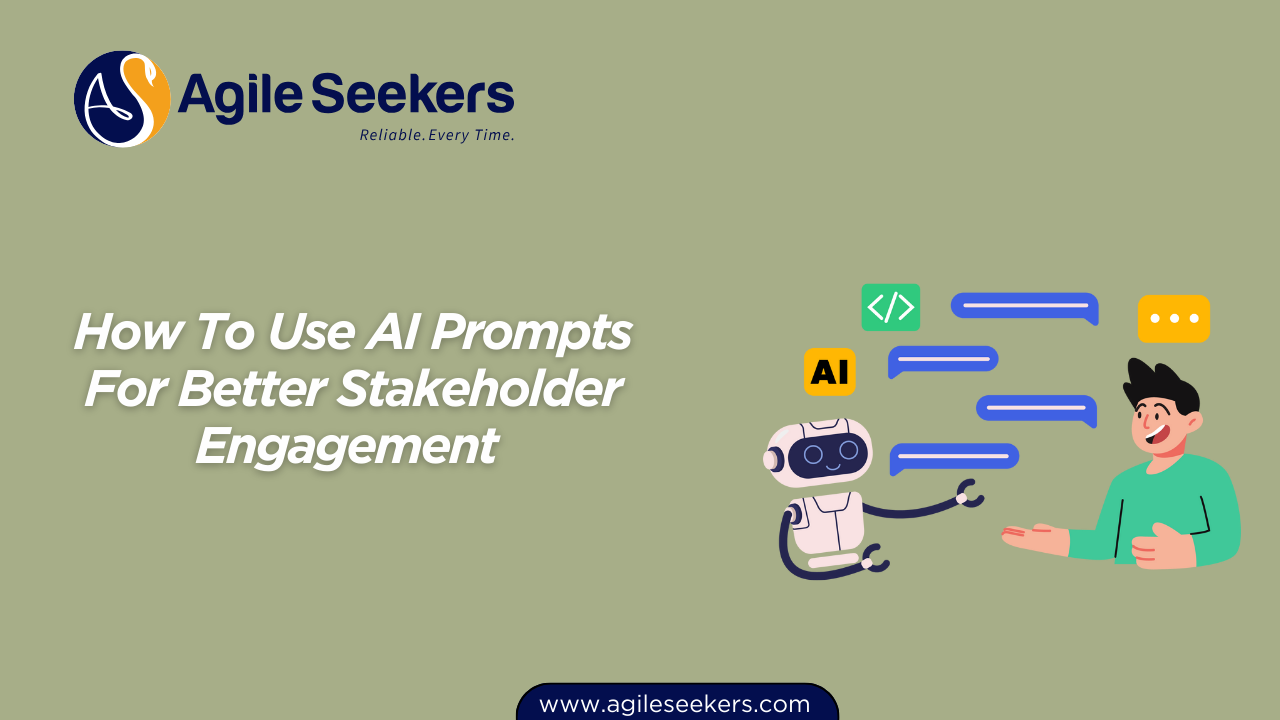How To Use AI Prompts For Better Stakeholder Engagement

Engaging stakeholders isn’t just about sending updates or scheduling meetings. It’s about building trust, creating alignment, and ensuring everyone feels heard. That’s where AI prompts come in. When used strategically, they can shape conversations, uncover insights, and strengthen relationships with stakeholders across projects and transformations.
This post breaks down how AI prompts can elevate stakeholder engagement, with practical examples and actionable steps.
Why Stakeholder Engagement Needs a Smarter Approach
Stakeholders—executives, customers, partners, or team members—bring different perspectives and priorities. Misalignment often comes from unclear communication, lack of context, or insufficient feedback loops. Traditional methods like long reports or one-off check-ins may not bridge that gap.
AI prompts change the game. By framing the right questions, you can use AI tools like ChatGPT or Miro AI to:
-
Generate multiple perspectives quickly.
-
Anticipate stakeholder concerns before meetings.
-
Structure discussions around shared goals.
-
Create personalized follow-ups that strengthen trust.
The outcome? Less friction, more collaboration, and better decisions.
Stage 1: Using AI Prompts to Prepare for Stakeholder Conversations
Preparation is half the battle in stakeholder management. AI prompts help you walk into discussions with clarity.
-
Mapping stakeholder interests
-
Prompt example: “List the top concerns of a CFO in a digital transformation project.”
This creates a perspective list that you can use to tailor your message.
-
-
Anticipating questions
-
Prompt example: “What objections might a product owner raise when introducing an AI-driven backlog prioritization system?”
-
-
Crafting agenda points
-
Instead of writing a generic agenda, use AI prompts to draft sharp discussion points.
Example: “Generate three agenda topics that balance delivery speed and long-term strategy for a stakeholder meeting.”
-
This kind of preparation aligns with what Agile leaders practice in the AI for Agile Leaders & Change Agents Certification—leveraging AI to make leadership conversations sharper and more value-driven.
Stage 2: Driving Engagement During Meetings with AI Support
AI prompts don’t replace the human element in meetings, but they amplify it.
-
Framing key messages
Use prompts like: “Rewrite this technical explanation for non-technical executives.”
This ensures clarity without overwhelming detail. -
Facilitating live discussions
AI-generated prompts can help facilitators surface the right questions:-
“What’s the simplest way to explain customer impact of this release?”
-
“Suggest neutral phrasing to address stakeholder disagreements.”
-
-
Supporting product-focused dialogues
Product owners often juggle competing demands. The AI for Product Owners Certification emphasizes how AI can guide backlog discussions. Prompts like “Prioritize these features based on customer value and business strategy” help stakeholders see the reasoning behind product decisions.
Stage 3: Strengthening Follow-ups and Continuous Engagement
Engagement doesn’t stop at the meeting. The way you follow up can determine whether stakeholders stay aligned.
-
Drafting personalized summaries
-
Prompt example: “Summarize this meeting for a time-constrained executive, highlighting risks and decisions.”
-
-
Keeping the narrative consistent
When different stakeholders need updates, AI prompts ensure messaging stays aligned while still customized.
Example: “Write a 200-word update for engineering leaders and a 100-word version for business sponsors.” -
Automating engagement touchpoints
For project managers, the AI for Project Managers Certification teaches how to integrate AI into progress tracking. A prompt like “Turn these sprint results into a stakeholder-friendly progress update” bridges the gap between raw metrics and meaningful impact.
Practical Examples of AI Prompts for Stakeholder Engagement
Here are scenarios where AI prompts add value:
-
Conflict resolution
-
“Suggest language to acknowledge stakeholder frustration without escalating tension.”
-
-
Risk communication
-
“Explain data security risks in simple terms for a board presentation.”
-
-
Vision alignment
-
“Draft three vision statements that balance innovation with compliance for stakeholder review.”
-
-
Engaging Scrum teams with stakeholders
The AI for Scrum Masters Certification highlights prompts for bridging teams and stakeholders:-
“Generate stakeholder questions to help Scrum teams refine their demos.”
-
The Role of Ethics and Trust in AI-Driven Engagement
While AI prompts can improve efficiency, over-reliance may reduce authenticity. Stakeholders value transparency. Here are a few guardrails:
-
Keep AI outputs as support, not replacement. Use prompts to frame thinking, not to outsource judgment.
-
Verify accuracy. AI can surface insights, but it’s your job to validate before sharing.
-
Maintain confidentiality. Sensitive data should never be fed into AI tools without safeguards.
For leaders navigating this space, external resources like the Harvard Business Review article on AI in leadership provide solid guidance on ethics and decision-making with AI.
How AI Prompts Build Stronger Stakeholder Relationships
The real power of AI prompts isn’t just saving time—it’s building stronger human connections. By anticipating needs, personalizing engagement, and creating clear narratives, AI enables stakeholders to feel informed, respected, and aligned.
Engaged stakeholders aren’t passive observers. They become active partners in transformation. And when that happens, projects move faster, trust deepens, and value creation accelerates.
Final Thoughts
AI prompts are more than productivity tricks—they’re enablers of meaningful conversations. Leaders, product owners, project managers, and Scrum Masters can all benefit from learning how to design and apply them in their work.
If you’re ready to go deeper, certifications like:
provide structured ways to embed AI into your role.
Stakeholder engagement thrives on clarity, empathy, and trust. With AI prompts as your ally, you can take those qualities to the next level.
Also read - The Role Of AI In Scaling Agile Across Enterprise Portfolios
Also see - AI Powered Techniques For Risk Identification In Agile Programs




















